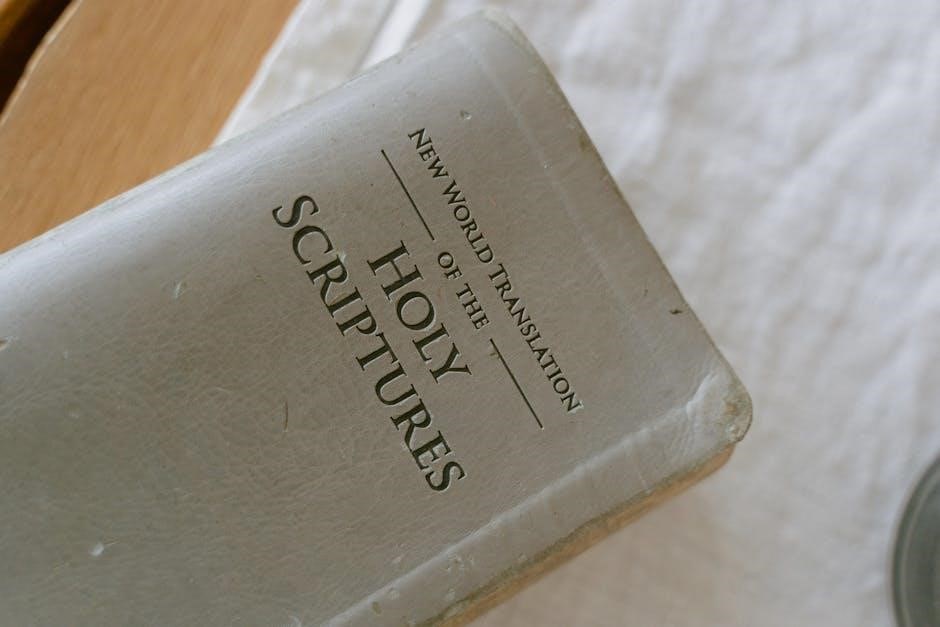when was the bible written timeline pdf

when was the bible written timeline pdf
The Bible, spanning over 1,500 years, includes 66 books written by diverse authors. Understanding its timeline provides clarity on historical contexts, literary styles, and theological developments, enhancing biblical study.
1.1 Overview of the Bible’s Composition
The Bible is a collection of 66 books written by numerous authors over approximately 1,500 years. Its composition spans from the Old Testament, written between 1200 BCE and 150 BCE, to the New Testament, composed between 50 CE and 150 CE. The Old Testament includes the Torah, Historical Books, Wisdom Literature, and Prophetic Books, while the New Testament comprises the Gospels, Epistles, and Apocalyptic Writings. The Bible’s diverse content reflects various literary styles, historical contexts, and theological themes. Understanding its composition provides insight into its structure and the collaborative effort of its authors.
1.2 Importance of Understanding the Timeline
Understanding the Bible’s timeline is crucial for interpreting its texts accurately. It provides historical context, revealing how events and writings are interconnected. Chronological clarity helps trace theological themes, such as covenant, redemption, and kingdom, across centuries. Recognizing the timeline aids in resolving apparent contradictions and understanding the progression of ideas. It also highlights the cultural and historical settings of each book, enabling deeper engagement with the text. Grasping the timeline enhances appreciation for the Bible’s unity amid diversity, showing how ancient writings remain relevant today. This framework is essential for scholars and readers seeking to uncover the richness and depth of Scripture.

The Old Testament Timeline
The Old Testament spans approximately 1,200 years, from creation to the Babylonian exile. It includes 39 books divided into Torah, Historical Books, Wisdom Literature, and Prophetic Books, chronicling Israel’s history, key events, and theological themes like covenant and redemption.
2.1 The Torah (Books of Moses)
The Torah, comprising Genesis, Exodus, Leviticus, Numbers, and Deuteronomy, forms the foundation of the Old Testament. Traditionally attributed to Moses, these books are believed to have been written between 1200 and 600 BCE. They recount the creation of the world, the early patriarchs, the Exodus from Egypt, and the giving of the Law. The Torah establishes key themes such as covenant, law, and the identity of Israel as God’s chosen people. Its narratives and legal codes provide a theological framework for understanding the rest of the Bible. The Torah’s historical and religious significance is central to both Judaism and Christianity, shaping their beliefs and practices.
2.2 Historical Books (Joshua to Esther)
The historical books, spanning from Joshua to Esther, narrate Israel’s history from the conquest of Canaan to the Persian period. These books, written primarily between 600–300 BCE, include Joshua, Judges, Ruth, 1-2 Samuel, 1-2 Kings, 1-2 Chronicles, Ezra, Nehemiah, and Esther. They detail key events such as the conquest, the monarchy, the divided kingdom, the exile, and the restoration of Jerusalem. Themes of faith, leadership, and divine judgment are central. Chronicles, for instance, focuses on Judah’s history, while Ezra-Nehemiah highlights post-exilic reconstruction. Esther unique
2.3 Wisdom Literature (Job, Psalms, Proverbs)
Wisdom Literature, including Job, Psalms, Proverbs, Ecclesiastes, and Song of Solomon, focuses on human experience, morality, and divine wisdom. These books, written between 1000–300 BCE, explore themes of suffering, justice, and the meaning of life. Job examines faith amidst adversity, while Psalms expresses a wide range of emotions and spiritual reflections. Proverbs offers practical advice on ethics and decision-making, emphasizing the fear of the Lord. Ecclesiastes reflects on life’s fleeting nature, urging readers to seek true fulfillment in God. Song of Solomon celebrates love and relationships, often interpreted allegorically. These writings provide timeless insights into human nature and the pursuit of wisdom, bridging historical narratives with deeper theological truths.
2.4 Prophetic Books (Isaiah to Malachi)
The Prophetic Books, spanning from Isaiah to Malachi, are a collection of writings by prophets who conveyed God’s messages to Israel and the nations. Written primarily between 750–400 BCE, these books address themes of judgment, repentance, and hope. Major Prophets like Isaiah, Jeremiah, Ezekiel, and Daniel are distinguished by the length and scope of their writings, while the Minor Prophets—Hosea, Joel, Amos, Obadiah, Jonah, Micah, Nahum, Habakkuk, Zephaniah, Haggai, Zechariah, and Malachi—are shorter but equally impactful. These prophets called Israel to covenant faithfulness, warned of impending judgment, and foretold future restoration. Their writings provide theological depth and a framework for understanding God’s plan of redemption, bridging the Old Testament narrative and foreshadowing the New Testament era.

The New Testament Timeline
The New Testament Timeline covers the life of Jesus Christ, the acts of the apostles, Paul’s epistles, and Revelation. Written between 50 AD and 120 AD.
3.1 The Gospels (Matthew to John)
The Gospels, written between 70-120 AD, narrate the life, teachings, death, and resurrection of Jesus Christ. Matthew, Mark, Luke, and John provide unique perspectives, with Matthew emphasizing Jesus as the Messiah, Mark focusing on His actions, Luke highlighting His humanity, and John presenting Him as the divine Word. These accounts, while differing in detail, collectively establish the foundational narrative of Christianity. The Gospels are placed at the beginning of the New Testament, setting the stage for the apostolic era and the spread of Christianity. Their composition spans several decades, reflecting the evolving understanding of Jesus’ mission and its significance for early believers.

3.2 The Epistles (Pauline and General)
The Epistles, written between 50-150 AD, are letters addressing early Christian communities. Pauline Epistles, such as Romans, Corinthians, and Philippians, emphasize faith, grace, and church unity. General Epistles, like Peter, James, and Jude, offer moral guidance and theological insights. These letters, while diverse, collectively provide practical wisdom, doctrinal clarity, and encouragement for believers facing challenges. They bridge the gap between the life of Jesus and the spread of Christianity, serving as foundational texts for Christian theology and practice. The Epistles reflect the dynamic growth of the early church, addressing specific issues while upholding universal truths. Their authorship and historical context remain vital for understanding their relevance and application today.
3.3 Apocalyptic Writings (Revelation)

The Book of Revelation, the only apocalyptic book in the New Testament, was written around 90-120 AD. Attributed to John of Patmos, it uses symbolic language and visions to convey divine judgment and ultimate triumph. This text is distinct for its vivid imagery, such as the seven churches, the four horsemen, and the final battle. Revelation provides hope and encouragement to persecuted Christians, emphasizing God’s sovereignty and the promise of eternal life. Its themes of eschatology and divine justice have deeply influenced Christian theology and art. As the closing book of the Bible, it serves as a powerful conclusion, reinforcing faith in Christ’s return and the establishment of a new heaven and earth.

Key Historical Periods Influencing Biblical Writing
The Persian, Hellenistic, and Roman periods significantly shaped the Bible’s composition, with each era influencing theological themes, cultural contexts, and the spread of early Christianity.
4.1 The Persian Period and Its Impact
The Persian Period (538–332 BCE) played a crucial role in shaping the Bible, particularly after Cyrus the Great’s conquest of Babylon. This era allowed Jews to return from exile, rebuilding Jerusalem and the Temple. Ezra and Nehemiah, key leaders, oversaw religious and cultural renewal, leading to the codification of Jewish law. Persian rulers supported Jewish religious practices, fostering an environment where biblical texts were compiled and preserved. The period also saw the completion of historical books like Ezra-Nehemiah and Chronicles, reflecting post-exilic realities. The Persian Empire’s tolerant policies indirectly influenced the Bible’s formation, as Jewish identity and worship practices were revitalized, laying the groundwork for future theological developments.
4.2 The Hellenistic and Roman Periods
The Hellenistic period (332–37 BCE) began with Alexander the Great’s conquests, spreading Greek culture and language, which influenced Jewish thought and the Septuagint’s creation. The Roman Period (37 BCE–476 CE) saw the rise of Herodian rulers and the life of Jesus Christ, central to the New Testament. Roman rule brought stability, facilitating the spread of Christianity, but also led to conflicts, such as the destruction of Jerusalem’s Temple in 70 CE. This era shaped the New Testament’s composition, with Pauline epistles and Gospels written during this time. The Roman Empire’s vast network and linguistic unity aided in the dissemination of biblical texts, while its political shifts impacted early Christian communities and the Bible’s final structure.

Archaeological Evidence and Dating
Archaeological findings, such as the Dead Sea Scrolls, provide insights into biblical manuscript origins, while carbon dating assists in verifying the age of texts, aiding timeline accuracy.
5.1 Manuscript Discoveries and Their Significance
The discovery of ancient manuscripts, such as the Dead Sea Scrolls near Qumran, has significantly enriched our understanding of biblical texts. These scrolls, dated between 150 BCE and 70 CE, include fragments of nearly every book of the Hebrew Bible, offering insights into textual accuracy and evolution. Similarly, the Codex Sinaiticus and Codex Vaticanus, dating to the 4th century CE, are among the earliest complete manuscripts of the Bible, providing valuable data for scholars. Such finds confirm the reliability of existing biblical texts and shed light on the historical context of their composition. These manuscripts are crucial for reconstructing the timeline of biblical writing and transmission, aiding scholars in dating specific books and understanding their development over centuries.
5.2 Carbon Dating and Textual Analysis

Carbon dating has revolutionized the study of biblical manuscripts by providing approximate dates for their composition. This method measures the decay of radiocarbon (C-14) in organic materials, such as parchment or papyrus, offering a scientific basis for determining manuscript age. While carbon dating cannot pinpoint exact dates, it helps verify the timeframes of biblical texts, aligning them with historical events. Textual analysis further refines this process by examining linguistic styles, vocabulary, and theological themes to assess a text’s historical context. Together, these methods enhance scholars’ ability to reconstruct the Bible’s timeline, ensuring a more accurate understanding of when and how its books were written and compiled over the centuries.

The Process of Canonization
The canonization of the Bible involved councils like Nicaea and Trent, where texts were selected based on apostolic origin and doctrinal consistency, solidifying its authority.
6.1 Formation of the Old Testament Canon
The Old Testament canon was formed over several centuries, with key milestones in the Persian and Hellenistic periods. After the Babylonian exile, Jewish leaders began compiling sacred texts, with the Torah gaining central status by 400 BCE. The process continued through the Second Temple era, with prophetic and wisdom writings added. By 200 BCE, most texts were recognized as authoritative. The Council of Jamnia, around 90 CE, finalized the Hebrew Bible, excluding apocryphal works. Criteria included divine inspiration, authorship by prophets or their associates, and thematic coherence with Israel’s covenant history. This canonization laid the foundation for the Old Testament, shaping Jewish identity and later Christian scripture.
6.2 Formation of the New Testament Canon
The New Testament canon emerged gradually, spanning the 1st to 4th centuries CE. Early Christian communities circulated texts like the Gospels and epistles, with recognition growing over time. By the 2nd century, key texts were widely accepted, but unanimity took centuries. Regional councils, such as Nicaea (325 CE) and Constantinople (381 CE), played pivotal roles. The Council of Nicaea affirmed the divinity of Christ, influencing which texts aligned with orthodox beliefs. Criteria included apostolic authorship, consistency with doctrine, and widespread use in worship. The process concluded by the late 4th century, with Athanasius’s festal letter (367 CE) and the Councils of Hippo (393 CE) and Carthage (397–419 CE) finalizing the 27 books of the New Testament.

Modern Resources for Studying the Timeline
Explore Bible timelines with PDF guides, online tools, and interactive charts. These resources provide visual and detailed overviews, enhancing understanding of the biblical narrative’s historical context.
7.1 PDF Timelines and Study Guides
PDF timelines and study guides offer comprehensive overviews of the Bible’s composition, providing detailed chronologies of when its books were written. These resources are ideal for visual learners, as they present historical events, authorship timelines, and thematic developments in an organized manner. Many PDF guides include color-coded sections, charts, and key event highlights, making complex information accessible. They cover both the Old and New Testaments, linking biblical texts to historical contexts. These tools are widely available online, often free to download, and are valuable for personal study or group discussions. By using these resources, readers can gain a clearer understanding of the Bible’s structure and historical background, enhancing their appreciation of its message.
7.2 Online Tools and Interactive Charts
Online tools and interactive charts provide dynamic ways to explore the Bible’s timeline, offering deeper insights into when its books were written. These resources often include zoomable timelines, historical maps, and event connections, making study engaging and intuitive. Many platforms, such as BibleGateway or StudyLight, offer interactive features that allow users to filter by time periods, themes, or authors. For example, some tools highlight the historical context of prophetic books or the apostolic era. These digital resources are particularly useful for visual learners and educators, enabling them to explore complex timelines and thematic relationships in real-time. By leveraging technology, these tools make the Bible’s timeline accessible and easier to understand for modern learners.